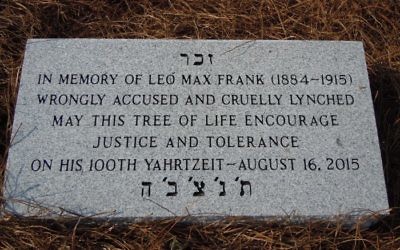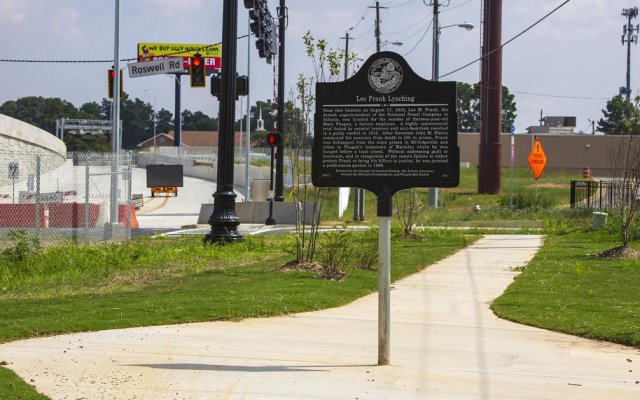Historical Marker of Leo Frank Returns
Removed four years ago for a road construction project, GDoT replaced the historical marker.
A historical marker commemorating the 1915 lynching of Leo Frank is returning after four years of absence. The sign was removed by the Georgia Department of Transportation during a construction project at Roswell Road and Freys Gin Road, two miles east of the Marietta Square. It is positioned across the street from Frank’s lynching site. A rededication ceremony was held Thursday, Aug. 23.
Aug. 17 marked the 103rd anniversary of Frank’s death. Convicted for killing 13-year-old employee Mary Phagan at the National Pencil Company, Frank was jailed in Milledgeville. The Jewish New York native was sentenced to death.
Gov. John M. Slaton conducted his own investigation and commuted Frank to a life sentence. In turn, citizens of Atlanta rioted. Kidnapped from jail by a lynch mob, Frank was hung from a tree in one of Georgia’s most harrowing acts of anti-Semitism.
The testimony of Alonzo Mann in 1982, 69 years after the lynching, prompted an official pardon of Leo Frank by the State Board of Pardons and Paroles. Mann witnessed Jim Conley carrying the body of Mary Phagan to the factory basement on the day of her death. Conley threatened Mann, who kept quiet until he reached his death bed at 83 years old.
Also remembering the Leo Frank case are the William Breman Jewish Heritage Museum and Marietta Museum of History. The Atlanta museums plan to commemorate Frank with a lecture by legal expert Van Pearlberg in June 2019. Deputy Attorney General and former Marietta City Councilman Van Pearlberg is one of the foremost experts on the Frank case.

Here’s a timeline of the events that led to Frank’s death:
- April 26, 1913: Mary Phagan, 13, is found sexually molested and murdered at the National Pencil Factory in Atlanta’s Grant Park neighborhood. She is buried in Marietta City Cemetery.
- April 27, 1913: Newt Lee, factory watchman, is arrested on suspicion of murder.
- May 1, 1913: Jim Conley, a black janitor at the National Pencil Company, is arrested after he was found rinsing his bloodied shirt.
- May 23, 1913: Leo Frank is indicted for murder.
- July 28, 1913: Frank’s trial begins.
- Aug. 25, 1913: After the trial concludes, a jury finds Frank guilty in less than two hours.
- Aug. 26, 1913: Frank is sentenced to execution by hanging, to take place Oct. 10, 1913.
- October 1913: In the wake of Frank’s conviction, the Anti-Defamation League is formed to defend civil rights and social justice.
- August 1913 to June 1915: Frank’s legal team files dozens of appeals, all of which are denied.
- April 9, 1915: The US Supreme Court rejects the final appeal and Frank’s execution is set for June 22, 1915.
- June 20, 1915: Gov. John M. Slaton grants a commutation of Frank from death penalty to life in prison.
- July 18, 1915: Frank is attacked by fellow prisoner William Creen.
- July 1915: Georgia’s populist leader and bigoted newsman, Thomas E. Watson, forms the Knights of Mary Phagan. Thousands of Jewish residents escape the city because police refuse to stop the lynch mob. Atop Stone Mountain, the group revived the Klu Klux Klan.
- Aug. 16-17, 1915: A mob cuts the electricity to the prison and kidnapped Frank, drives him to Marietta, Phagan’s hometown, and hangs him from an oak tree. He is buried in Glendale, N.Y.
- 1920: Watson is elected to U.S. Senate.
- March 4, 1982: On his death bed, Alonzo Mann confesses he saw Jim Conley moving Mary Phagan’s body to the basement of the National Pencil Factory on the day of her death.
- March 11, 1986: The Georgia Board of Pardons and Paroles grants Frank a posthumous pardon.




comments